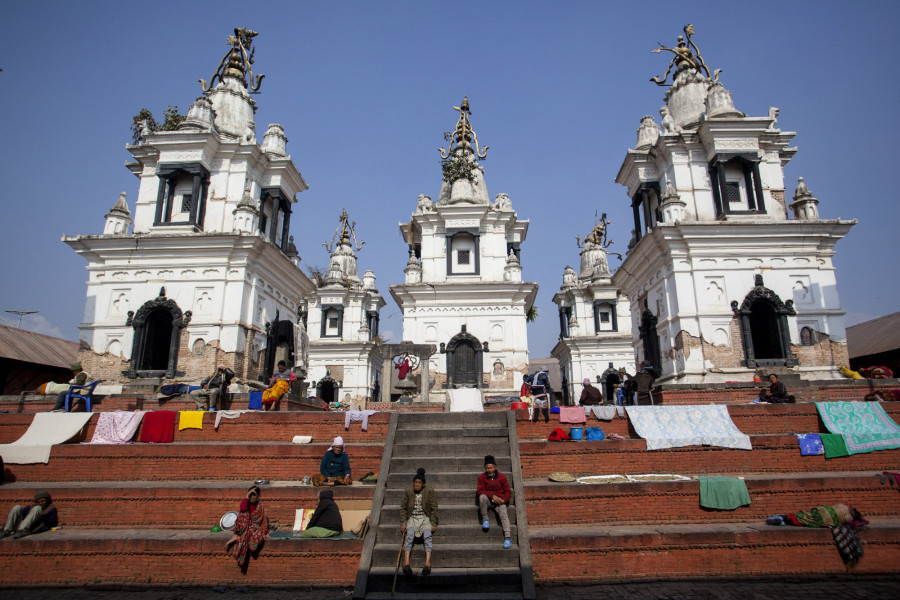National
Old age homes on high alert to prevent coronavirus spread
As Covid-19 continues to spread, facilities dedicated to taking care of the elderly are adopting strict measures.
Tsering Ngodup Lama
A walk to the Matatirtha temple was the highlight of the day for the residents of Matatirtha Old Age Home. They would also enjoy the interactions with volunteers that came to talk to them and make donations to the Home.
But since March both have stopped in fear of the coronavirus.
Covid-19 may not have hit old age homes in Kathmandu like it did in the West but the management at Matatirtha Old Age Home, like others in Kathmandu, is taking no chances.
“We have stopped not only visitors but also the residents’ daily temple visits,” said Dharma Maharjan, a member of the establishment’s management committee.
According to an April report from the London School of Economics, between 42 and 57 percent of Covid-19 deaths in Italy, Spain, France, Ireland, and Belgium have been linked to care homes for the elderly. In the UK, by mid-May, a quarter of Covid-19 deaths were in elderly homes.
While the number of elderly/nursing homes is much fewer in Nepal compared to the West, as elderly parents live with their children here, they cannot afford to take risks.
“All our residents are aged 70 and above. The older you get, the weaker your immune system gets, and on top of that, many of our residents have pre-existing conditions like high blood pressure, asthma, diabetes. If one of our residents contracts Covid-19, it will spread rapidly to our other residents, and we can’t afford to take that risk,” said Maharjan.
Located on the outskirts of Kathmandu, Matatirtha Old Age Home is one of the city's better known old age homes. Ever since the not-for-profit home was established in 1997, it has become a shelter for elderly women who have no family members willing to look after them.
The decision to stop the daily temple visits and not allowing visitors has not gone down well with the 19 women who live at the Home.
They keep asking us why they no longer get to go visit the temple or have any visitors,” said Maharjan. “We tell them about Covid-19, how infectious the disease is and how old people are very likely to contract it. Most of them do not understand these things, and those who do, tend to forget it, so we have to keep telling them.”
For the residents, the daily visit to the temple was an opportunity to step outside the home’s premises, a change in settings. Since none of the home’s residents has family members or loved ones visiting them, the only visitors they get are people who come to make donations. “Many visitors also spend time and interact with the elderly. Our residents love it when they get such visitors,” said Maharjan.
Restricting visitors is one of the most common measures old age/nursing homes have taken to prevent the spread covid-19 inside the facilities.
During the first three months of the nation-wide lockdown, Naman Care Home, a for-profit senior rehabilitation facility, didn’t allow a single visitor. The home currently has 13 residents, all above the age of 60 who have had accidents and suffered strokes.
“Now we do allow visitors but only when they are absolutely necessary,” said Pravesh Adhikari, founder of Naman Care Home. “All visits happen in a separate dedicated room and visitors and residents must wear protective gear.”
But for the residents of Naman who are used to having family members visiting them, the restrictions on visitors for the past few months haven’t been easy.
“Before the pandemic, family members of residents visited every few days, so the prolonged absence of visits is bound to be difficult,” said Adhikari. “We also help our residents get in touch with their loved ones via video chats so that they stay connected virtually despite the physical distance.”
Meanwhile, the residents are kept busy with activities, from playing games, music therapy, physiotherapy, occupational therapy, according to Adhikari.
There is no data available on the number of old age homes in Kathmandu Valley or across the country. According to the Social Welfare Council, there are four non-profit ones and private operators say there are about a dozen in the Valley.
Old age homes have also doubled down on sanitisation and hygiene. “Hygiene and sanitisation are two areas that we have put a very strong emphasis on. We sanitise the premises from time to time and have made it mandatory for our staff and residents to wash their hands frequently. In order to limit exposure to our residents, the majority of staff are residential,” said Adhikari.
The staffers at Matatirtha Old Age Home, says Maharjan, have been doing their best to ensure hygiene and cleanliness. “We sanitise the rooms once a day, provide masks and sanitisers to our residents,” said Maharjan.
Since Matatirtha Old Age Home relies heavily on donations for its daily operations, says Maharjan, the pandemic and the months of lockdown have directly impacted the donation stream.
“Donations have decreased more than 70 percent compared to pre-lockdown times,” said Maharjan. “We have even requested the government to provide our residents with masks, sanitisers, gloves and soaps, but we haven’t heard anything from them.”
Both Maharjan and Adhikari say that it’s very important that old age homes and nursing homes do everything they can to prevent the spread of infection inside the facilities. “Most such facilities in the country do not have the required physical infrastructure or the manpower to deal with the spread of Covid-19. In such a scenario, prevention is key,” said Adhikari.
According to the Health Ministry, the total number of Covid-19 patients above the age of 61 stands at 1,214 across the country so far.
Matatirtha Old Age Home and Naman Care Home haven’t had a single case of Covid-19 so far there are no reports of cases in other old age homes either.
“Our goal is to keep it that way,” said Maharjan. “But if the infection spreads once, it will be very hard to contain and the results will be catastrophic.”




 19.12°C Kathmandu
19.12°C Kathmandu















